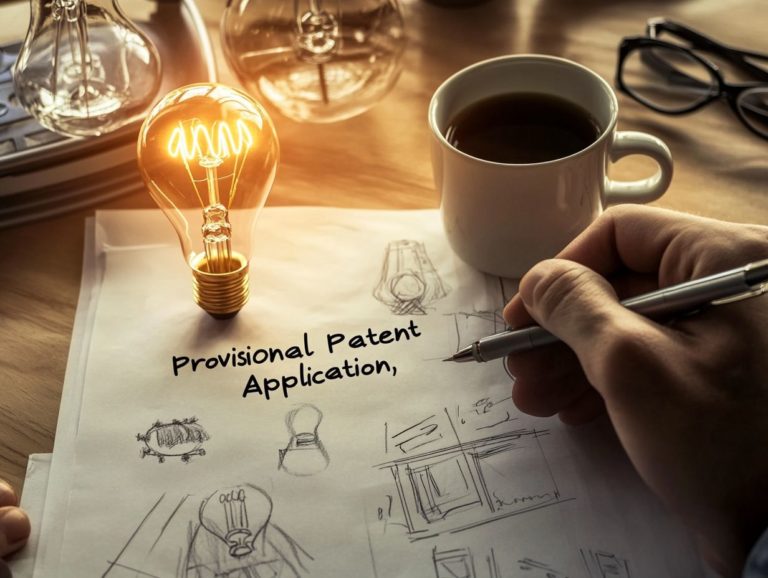5 Steps to Conducting a Patent Landscape Analysis
In today s fast-paced, innovation-driven market, understanding patents is essential for any business eager to maintain a competitive edge.
This article presents a practical five-step approach to conducting an effective patent landscape analysis, guiding you through everything from defining your objectives to drawing actionable conclusions. You ll discover the significance of this analysis, the different types available, and how you can leverage these insights to refine your strategies.
We ll tackle common challenges you may face and offer tips for staying updated in this ever-evolving field. Dive into the world of patent insights and supercharge your business strategy!
Contents
- Key Takeaways:
- 1. Define the Purpose and Scope of the Analysis
- 2. Gather Relevant Data
- 3. Analyze and Organize the Data
- 4. Identify Key Findings and Trends
- Why Is Patent Landscape Analysis Important?
- What Are the Different Types of Patent Landscape Analysis?
- What Are the Key Components of a Patent Landscape Report?
- How Can a Business Use Patent Landscape Analysis to Inform Their Strategy?
- What Are the Common Challenges in Conducting a Patent Landscape Analysis?
- How Can a Business Stay Updated on Patent Landscape Changes?
- Frequently Asked Questions
- What is a patent landscape analysis and why is it important?
- What are the five steps involved in conducting a patent landscape analysis?
- What is the first step in conducting a patent landscape analysis?
- How do you search and collect patents for a landscape analysis?
- How to Search and Collect Patents
- Analyzing and Categorizing Patents
- Visualizing Patent Landscape Results
- Understanding Patent Landscape Analysis
- Steps in Conducting a Patent Landscape Analysis
- Defining the Analysis Scope
Key Takeaways:

Clearly define the purpose and scope of the analysis before gathering data.
Analyze and organize the data to identify key findings and trends.
Use the findings to draw conclusions and make informed recommendations for business strategy.
1. Define the Purpose and Scope of the Analysis
Defining the purpose and scope of your Patent Landscape Analysis is key to understanding your competitive position. It offers you a structured approach to comprehend your market standing and understand the potential of your patent data in relation to stakeholders, competitors, and emerging technologies.
Establishing clear objectives not only streamlines your analytical process but also gives you the power to make informed decisions. By outlining goals such as identifying market opportunities, assessing patentability, and shaping your research and development strategies, you can channel your efforts more effectively.
Aligning your patent analysis objectives with your broader business strategies is key, as it amplifies your overall impact and ensures that the insights you gain lead to actionable outcomes. Ultimately, a well-defined purpose enhances your ability to anticipate industry trends and adapt proactively, driving sustainable innovation in a constantly evolving landscape.
2. Gather Relevant Data
Gathering relevant data is your first step in conducting a thorough Patent Landscape Analysis. This process uses patent databases and software tools to gather important market information that shapes your competitive and innovation strategies, including insights on how to conduct a patent due diligence.
You ll tap into a wide array of sources, including various patent databases, scientific literature, and in-depth market reports that illuminate emerging trends and technological advancements.
With the help of advanced software tools, you can efficiently navigate through vast amounts of data, ensuring the insights you gather are both actionable and pertinent.
To maintain high data quality, it’s essential to implement regular updates and validation checks. Employing systematic categorization methods can significantly enhance the usability of the information you collect, giving you the power to make informed decisions grounded in comprehensive analyses.
3. Analyze and Organize the Data
Analyzing and organizing your data is crucial for your Patent Landscape Analysis. This process transforms raw information into actionable insights through structured monitoring and effective visualization techniques, like utilizing charts and categorization.
Grasping the methodologies involved is crucial for drawing meaningful conclusions. Various statistical methods, including regression analysis and clustering techniques, can unveil underlying trends and relationships within the data.
Employing visual analytics allows you to create compelling narratives through graphs and heat maps, making complex information much more digestible.
Properly categorizing the data facilitates easier comparison, leading to deeper insights into innovation patterns and technological advancements. Moreover, rigorous data cleanup processes are fundamental.
Ensuring accuracy and consistency in your data guarantees that subsequent analyses are reliable and valid, giving you the power to make informed decisions.
4. Identify Key Findings and Trends
Identifying key findings and trends is a vital step towards success in Patent Landscape Analysis. It provides you with invaluable insights into competitive dynamics, emerging technologies, and potential opportunities for licensing and Research and Development (R&D) efforts.
By recognizing these patterns, you must make informed decisions about your innovation strategies and anticipate market shifts. Interpreting data results becomes essential in this context, allowing you to pinpoint not only current industry leaders but also rising players that could disrupt the status quo.
Utilizing charts and visual aids can significantly enhance your understanding, making complex data more accessible and actionable. For example, a leading tech firm effectively harnessed trend identification from patent filings to pivot its R&D priorities, ultimately outpacing competitors by developing a groundbreaking product that addressed an emerging market need.
Why Is Patent Landscape Analysis Important?
Patent Landscape Analysis is essential for you as it offers a thorough overview of the current state of intellectual property within relevant technology sectors. This insight enables you to make informed decisions about innovation, market positioning, and IP management in today s competitive landscape.
By effectively mapping out existing patents and technologies, you can uncover market trends that guide your future investments and collaborations. This analysis also reveals potential licensing opportunities, enhancing your revenue streams and fostering strategic partnerships.
With this information at your fingertips, you can more accurately assess patentability, reducing the risks tied to research and development initiatives.
In a rapidly evolving marketplace, understanding these dynamics helps shape robust R&D strategies, giving you the power to innovate with confidence. Ultimately, this analysis serves as a critical tool for bolstering your competitive intelligence, equipping you with valuable insights that pave the way for sustainable growth.
What Are the Different Types of Patent Landscape Analysis?

You can explore several types of Patent Landscape Analysis, each tailored to specific aspects of patent data, offering unique insights into competitive positioning, innovation potential, and market dynamics.
For instance, a technology landscape analysis provides you with a comprehensive overview of emerging technologies, helping you identify trends and gaps ripe for innovation.
On the other hand, competitor analysis takes a closer look at the patent activities of rival companies, allowing you to benchmark your innovations and devise effective strategies.
Then there’s licensing analysis, which helps you understand potential partnerships and revenue-generating opportunities through technology exchanges.
Various software tools can streamline these analyses by automating data collection and visualization, making it easier for you to derive actionable insights efficiently. The outcomes? Improved decision-making and enhanced focus on R&D, along with strategic management of your intellectual property.
What Are the Key Components of a Patent Landscape Report?
A comprehensive Patent Landscape report contains several key components that illuminate the analyzed data, providing you with visualizations, detailed findings, and strategic recommendations tailored to technology areas and market dynamics.
It all starts with an executive summary, which distills the overarching insights for quick comprehension. This makes it easier for you and other stakeholders to grasp the significance of the findings without getting lost in the details.
Following that, you’ll find a series of carefully curated charts that visually represent trends and patterns in patent filings, allowing you to visualize the competitive landscape at a glance.
The analytical findings then dive deeper into specific data points, offering clear explanations about innovation hotspots and market gaps. This clarity and organization are essential, as they transform complex information into actionable intelligence.
With this report in hand, decision-makers like you can navigate strategic plans effectively, armed with the insights needed to make informed choices.
Don t miss out on the insights that could redefine your strategy!
How Can a Business Use Patent Landscape Analysis to Inform Their Strategy?
You can leverage Patent Landscape Analysis to refine your strategy. It uncovers market opportunities and helps you optimize your research and development (R&D) efforts.
This approach empowers you to identify emerging trends and highlight gaps in the market. Make informed decisions that drive your business forward.
For instance, a leading pharmaceutical company might scrutinize patent filings. This helps prioritize its innovation pipeline, ensuring that new drugs meet unmet medical needs.
Technology firms also harness these insights for product development. This approach helps them avoid infringement while identifying potential partnerships or licensing opportunities that can accelerate growth.
Analyzing competitors patents enhances your strategies. This makes your organization more agile and better positioned to seize opportunities in an ever-evolving landscape.
What Are the Common Challenges in Conducting a Patent Landscape Analysis?
Conducting a Patent Landscape Analysis comes with challenges. These include data quality issues and the complexity of patent categorization.
You may grapple with data overload. The sheer volume of patents can daunt even the most experienced analysts.
A lack of expertise within your team can lead to misinterpretations of data. This jeopardizes the reliability of your analysis.
Adopt best practices to navigate these hurdles:
- Prioritize quality over quantity.
- Utilize advanced analytics tools to sort and categorize patents efficiently.
- Invest in training programs to boost your team’s capabilities.
Cultivating a deeper understanding of the patent landscape enhances strategic decision-making. Maintain a robust competitive edge.
How Can a Business Stay Updated on Patent Landscape Changes?
Stay ahead of Patent Landscape changes. Implement ongoing monitoring strategies and leverage market intelligence tools for real-time insights.
This proactive approach is essential since the patent system is always changing. New inventions, market demands, and legislative shifts shape it continuously.
Subscribe to patent databases for a treasure trove of information. This access allows you to track relevant patents and published applications efficiently.
Utilize patent analytics software to perform comprehensive analyses. Uncover patterns that can guide your R&D directions.
Engage with IP forums to enhance knowledge sharing. This creates an ecosystem where insights about the patent landscape are readily exchanged.
Ultimately, this equips you to navigate changes with greater agility and confidence.
Frequently Asked Questions
What is a patent landscape analysis and why is it important?
A patent landscape analysis is a thorough examination of patents in a specific field or technology. It helps identify existing patents, their owners, and their potential impact on future research and product development.
This analysis provides valuable insights into the competitive landscape. It highlights potential risks and opportunities for informed innovation decisions.
What are the five steps involved in conducting a patent landscape analysis?
The five steps are: 1) define the scope and objectives, 2) search and collect patents, 3) analyze and categorize the patents, 4) visualize the results, and 5) interpret and utilize the findings for decision-making.
What is the first step in conducting a patent landscape analysis?
The first step is defining the scope and objectives. Determine the technology or field to analyze, the time frame, and specific objectives like identifying competitors or assessing market trends.
How do you search and collect patents for a landscape analysis?
To search and collect patents, utilize databases and search tools designed for patent research. Focus on keywords and classifications related to your field of interest.
How to Search and Collect Patents
Use patent databases like the USPTO or Espacenet to find patents. You can search by keywords, classification codes, and citations. Remember to include both granted and pending patents.
Analyzing and Categorizing Patents
Analyze patents based on technology, ownership, location, and filing date. This helps identify trends and key players in the market.
Visualizing Patent Landscape Results
Common tools for visualization include patent mapping, charts, and heat maps. These formats make your findings clearer and easier to understand.
Understanding Patent Landscape Analysis
A patent landscape analysis examines patents in a specific field. It reveals existing patents, their owners, and potential impacts on future developments.
Steps in Conducting a Patent Landscape Analysis
The five steps are: 1) Define the scope and objectives, 2) Search and collect patents, 3) Analyze and categorize, 4) Visualize results, and 5) Interpret findings.
Defining the Analysis Scope
The first step is defining the scope and objectives, including the field of technology, time frame, and specific goals like identifying competitors.







